General
Mineral King: Disney’s project that we never got to see … or ski
As Jim gets ready for his next trip west, he talks a bit about Walt Disney Productions’ Mineral King project. That state-of-the-art ski area that Disney dreamed of building right next door to California’s Sequoia National Park.

You know where I’m headed next week? The San Francisco Bay area. Why for? Because Nancy wants to check out some animation schools up thataway. There’s one in Emeryville, CA (home of Pixar!) that we’ll be checking out next Tuesday morning. Plus there’s some art academy in downtown S.F. that she also wants to take a peek at.
Yeah, that 7-to-8 hour drive up all the way from Anaheim is going to be a bit of a drag. But the upside is — since we’re going to be staying overnight in the Bay area — that means that, on our way down back to Southern California, we can take a detour … and visit a place that I’ve wanted to go to: Mineral King.
Why would I want to go ‘way out in the woods (particularly since I already live out in the woods of New Hampshire)? Because I’ve always wanted to see this section of Sequoia National Park. The place where Walt Disney wanted to build a state-of-the-art ski area back in the mid-1960s.
What? You’ve never heard about Mineral King and/or Disney’s dream to build a ski area up there? Don’t tell me that you’re one of those folks who thinks that the Walt Disney Company has only gotten interested with the world of sports over the past ten years or so? Truth be told, decades before Eisner opted to have the company create the Anaheim Mighty Ducks franchise for the NFL or buy a controlling interest in the California Angels or okay the construction of WDW’s Wide World of Sports complex, Walt himself had a keen interest in getting the company involved in both professional and amateur athletics.
Most folks date Walt’s athletic interest back to the 1960 Winter Olympics, which were held in the beautiful Squaw Valley area of Northern California. To make sure that these Olympic Games (tThe first to be held in the western United States, and more importantly, the first time the Winter Games would ever be televised) were particularly memorable, the California Olympic Organizing Committee knew that the Squaw Valley games would have to have some extremely impressive Opening and Closing Ceremonies. So which world-renown showman did they tap to ride herd on the festivities?
You guessed it. Walt Disney.
Walt came through in a big way for the California Organizing Committee, supervising a show that’s still talked about today in parts of Placer County. The pageant featured dozens of high school bands and choirs performing in unison, the release of 2000 white doves, fireworks, national flags that were dropped by parachute as well as the launch of thousands of multi-colored helium-filled balloons. This dazzling display featured over 5000 participants. According to accounts of the day, it was an eye-popping, jaw-dropping spectacle that set the standard for all Olympic Opening and Closing Ceremonies yet to come.
But — at least according to Disney history fans — the big thing that came out of Walt’s involvement in the 1960 Squaw Valley Winter Olympic Games wasn’t that Disney forever raised the stakes for all those poor slobs who have to stage Opening and Closing Ceremonies. But — rather — it was that Walt fell in love with Northern California. He really came to appreciate the rough grandeur of this remote region of the Golden State, its lush green forests as well as the numerous seasonal recreational opportunities that this area offered. And Disney longed to find a way to make this beautiful terrain more accessible to the general public.
Much the same as Disneyland had re-invented the American amusement park, Walt now wanted to try his hand at improving how people experienced the great outdoors. So — five years later — when the U.S. Forest Service proposed turning the Mineral King Valley of Sequoia National Forest into an outdoor recreation area, Disney quickly made sure that Walt Disney Productions put in a bid on the project.
Most folks scoffed when they heard about this, figured that all that Walt wanted to do was pull down those 300-year old redwoods to make room for yet another theme park. Which was why a lot of people were stunned when they heard details about Walt Disney Productions’ plan for the Mineral King area.
Working directly with Willie Schaeffler, an Olympic course designer who had helped create the highly praised facilities for the 1960 Winter Olympics in Squaw Valley, Walt’s plan was nothing if not ambitious. It called for building a $35 million ski resort that would attempt to give visitors the best possible experience while still having the smallest possible impact on the Northern California high country.
Even by today’s eco-friendly standards, some of Walt’s plans for the Mineral King project seem remarkably forward-thinking. Recognizing the negative impact that cars and their exhaust would have on the delicate woodlands, Disney proposed banning cars entirely from his Northern California resort.
Guests arriving for a fun weekend at the Disney-designed version of Mineral King would first be directed to park their autos inside of the resort’s heated subterranean parking garage. After unpacking their cars and checking in at the reception center, guests would have then been directed to the resort’s electrically powered cog railway. This environmentally friendly system would have quickly and quietly moved vacationers a mile and a quarter from the valley floor up to Mineral King’s main village (providing a breath-taking view of the wilderness in the process).
Here, visitors would have found a full assortment of Disney-run hotels, restaurants and shops done in the Alpine American style. At full build-out, the Mineral King resort would have provided overnight accommodations for just over 3000 guests. These hotel rooms would have been located inside dozens of low-slung, rough-hewn structures that would deliberately never be built any higher than 3 to 4 stories. That’s so that the buildings in Mineral King’s main village would never upstage the real stars of the show: the majestic mountain peaks that surrounded the ski resort.
With its dozen Olympic-quality ski runs cut carefully into the side of the mountain (to preserve the area’s beauty as well as have minimum impact on the forests right next to these ski trails), Mineral King sounds like a great place to spend a winter weekend, right? Well, Walt envisioned this beautiful piece of Northern California as being a year-round resort. A place that would still have plenty of entertainment opportunities for those folks who ventured up into the woods beyond Sequoia National Forest long after the snow was gone.
That’s why Walt’s plans for the place called for a series of hiking trails to be carved out of the wilderness. Guests could have joined trained staffers on nature walks through the woods, where they’d have learned all about Northern California’s flora and fauna. There’d also stables on site for those who wanted to go horseback riding for an afternoon. Plus a restful and refreshing pool complex for those who wanted to take a refreshing swim.
Of course, no matter what the season was, those guests staying in Mineral King’s main village complex were still going to be looking for fun things to do once the sun went down. That’s why the Imagineers put together a resort master plan that called for construction of a small movie theater (which would have shown only the very latest film from Walt Disney Studios, of course). These plans also carved out a spot for a comfortable bar area that would have featured an enormous fireplace as well as a huge series of picture windows that looked directly out on the ski trails & the beautiful mountains beyond.
Sounds like fun already, doesn’t it? Well, Walt felt that the place still needed a little something more. That little bit of Disney magic that would really help put the Mineral King resort on the map.
Walt puzzled at this one for a while. Then it came to him. Some sort of show — something similar to what Walt was doing at Disneyland. (After all — whether it was fair or not — people were still going to compare Disney’s new ski area to his world famous Anaheim theme park. So why not give them a little taste of Disneyland magic while they’re out here in the wilderness?) Only — to fit the rustic setting — the show should be built around … bears.
Though much has been written over the past 73 years about Walt’s affection for a certain mouse, what’s not as well known is Disney’s huge interest in bears. Putting it bluntly, Walt thought that bears were funny as hell. For example: Disney absolutely loved those “Humphrey the Bear” cartoons that Jack Hannah churned out for the studio back in the 1950s. That’s why Walt had the bears from these shorts play such a prominent role in the animated opening for “The Mickey Mouse Club.”
Recognizing that the public might also share his interest in the behavior of bruins, Disney insisted that — while WED was reworking Disneyland’s “Rainbow Cavern” ride in late 1959 so that it could become the “Mine Train Through Nature’s Wonderland” — that a huge section of the ride be devoted to bears. Many fans of this long-gone Frontierland attraction now consider the “Bear Country” section of the attraction — where guests rode across a high trestle and looked down at some robotic bears who were trying to catch some plastic fish — to have been the real high point of the show.
And let’s not even get started on Winnie the Pooh and/or Baloo the Bear from “The Jungle Book,” the stars of the last two animated projects that Walt personally green-lit … let’s face facts, folks. Walt Disney really liked bears.
Which was why — after he initially envisioned this bear show for Mineral King — Walt turned to one of his top Imagineers, Marc Davis, and asked him to personally take a whack at the project. After all, Marc had just finished designing all the characters to be featured in Disneyland’s soon-to-be-opened “Pirates of the Caribbean.” This was Davis’ follow-up to his daring work on Adventureland’s “Enchanted Tiki Room.” So here was a guy who could clearly build an entertaining attraction out of any sort of subject matter.
Walt handed off this task to Marc in the early fall of 1966, just about the same time that Disney and then-California Governor Edmund G. Brown held a press conference to officially unveil Walt Disney Productions’ plans for the Mineral King property. Disney’s proposal for the area was generally met with much approval and acclaim. (Though a small faction of the Sierra Club took issue with the proposed widening of the property’s access road through Sequoia National Forest, a key component to Disney’s Mineral King development. These club members’ concerns — which seemed minor and manageable back in the fall of 1966 — would eventually grow to the point where the Supreme Court of the United States had to get involved, deciding whether it was even legal for the U.S Forest Service to allow this sort of development to go forward on federally owned land … But let’s not get ahead of ourselves, shall we?) So much so that — just six weeks after the initial Mineral King announcement — Walt Disney was awarded the American Forestry Association award for “outstanding service in the conservation of American Resources.”
Mineral King — at this point, anyway — looked like a done deal. Which is why Marc Davis devoted weeks of his time to doing preliminary design work on the ski area’s bear show. Marc covered the walls of his office in Glendale — floor to ceiling — with comical pictures of bears. Bears singing in barbershop quartets. Bears performing in Dixieland bands. Bears riding on bicycles built for two. Bears in formal attire — full length gowns, top hat and tails — getting ready to sing opera. Davis did some of his very best work on this project.
On the other hand, Walt was going through a particularly rough patch. For years now, Disney had been troubled by what he thought was an old polo injury. Unable to take the pain any longer, Walt went across the street to Burbank’s St. Joseph hospital to undergo a battery of tests. The doctor’s verdict: cancer. Surgery was performed to remove a portion of Disney’s left lung. But overall, the prognosis was grim.
After a short stay at the hospital to recuperate from the surgery, Walt returned to the studio and tried to resume his regular schedule. Understandably, Disney didn’t have the energy now that he once had. But Walt still insisted on making his rounds.
Which is how — one day in December — Disney found himself in Marc Davis’ office. Walt spotted one sketch in particular — a fat little bear that was playing a tuba — and just laughed and laughed. He told Marc that “I think you’ve got a real winner with this bear band idea.”
With that, Walt got up and — as he turned to go — said “Goodbye, Marc.” This kind of took Marc by surprise, because Walt was never one for pleasantries with his staff. Disney usually exited a meeting without saying a word. At best, Walt would say “So long” of “See ya later” as he breezed out the door on his way to his next meeting.
But for Walt Disney to say “Goodbye, Marc” — and then turn in the hallway as he was exiting WED and wave one final time to Davis — was all that Marc Davis needed to confirm his growing fears. He went home that night and told his wife, Alice that “I think Walt’s dying.”
Sure enough, just a few days later, Walt Disney did pass away. And — as a direct result — Walt Disney Productions’ ambitious plans for the proposed Mineral King ski resort began to falter almost immediately.
Mind you, it’s not like this project didn’t have its supporters. The Skiing industry — immediately recognizing the ingenuity of what Walt was proposing for that U.S. Forest Services property outside of Sequoia National Forest — posthumously awarded Disney the Hans Georg Award, which is annually presented to the individual who has done the most that year to elevate the sport of skiing. That’s how strongly these folks believed in the Mineral King project. They honestly believed that — if the ski area that Walt had proposed had actually gone forward — it would have changed the skiing industry forever.
There are also those today who say that — if Walt had lived just a few more years — Mineral King would have happened. That Disney had the personal charm necessary to win over those environmentalists who were uneasy about the project. More to the point, Walt had the clout to get those government officials who were dragging their heals to move quickly to get the necessary clearances. Which meant that — if all had gone according to plan — the very first skiers could have begun shushing down those carefully groomed Disney-designed slopes by the winter of 1973.
But that obviously didn’t happen, folks. Thanks to a vocal minority within the Sierra Club which felt that any development of Sequoia National Forest — no matter how well planned and/or how ecologically friendly it might be — was just plain wrong. So these people kept the project tied up in court for years, until Walt Disney Productions — tiring of the endless legal maneuvering as well as all the bad publicity that was now associated with the Mineral King development plan — abandoned its plans for this site in the early 1970s.
The Walt Disney Company then tried to get a similar state-of-the-art ski resort built on Independence Lake right outside of Truckee, CA. But that project never made it off the drawing board either …
But Marc’s plans for a bear based attraction? Someday soon, I hope to do a full blown series for JimHillMedia.com about the creation of that particular attraction.
For now, I’m just trying to get ready for this week’s trip to California. Digging out all of my old Mineral King brochures and press releases. So — when I’m standing by the road next Wednesday morning, pointing out into the wilderness — I can tell Nancy “I think that the ski lodge was supposed to be built over there.”
General
Seward Johnson bronzes add a surreal, artistic touch to NYC’s Garment District

Greetings from NYC. Nancy and I drove down from New
Hampshire yesterday because we'll be checking out
Disney Consumer Products' annual Holiday Showcase later today.
Anyway … After checking into our hotel (i.e., The Paul.
Which is located down in NYC's NoMad district), we decided to grab some dinner.
Which is how we wound up at the Melt Shop.
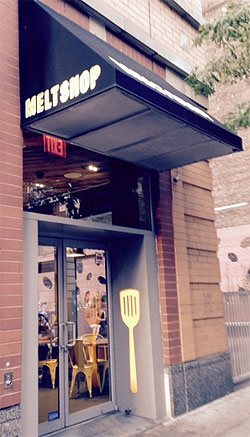
Photo by Jim Hill
Which is this restaurant that only sells grilled cheese sandwiches.
This comfort food was delicious, but kind of on the heavy side.

Photo by Jim Hill
Which is why — given that it was a beautiful summer night
— we'd then try and walk off our meals. We started our stroll down by the Empire
State Building
…
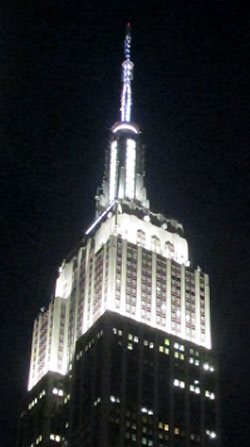
Photo by Jim Hill
… and eventually wound up just below Times
Square (right behind where the Waterford Crystal Times Square New
Year's Eve Ball is kept).

Photo by Jim Hill
But you know what we discovered en route? Right in the heart
of Manhattan's Garment District
along Broadway between 36th and 41st? This incredibly cool series of life-like
and life-sized sculptures that Seward
Johnson has created.

Photo by Jim Hill
And — yes — that is Abraham Lincoln (who seems to have
slipped out of WDW's Hall of Presidents when no one was looking and is now
leading tourists around Times Square). These 18 painted
bronze pieces (which were just installed late this past Sunday night / early
Monday morning) range from the surreal to the all-too-real.
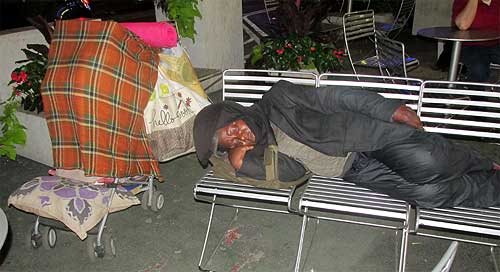
Photo by Jim Hill
Some of these pieces look like typical New Yorkers. Like the
business woman planning out her day …

Photo by Jim Hill
… the postman delivering the mail …

Photo by Jim Hill
… the hot dog vendor working at his cart …

Photo by Jim Hill
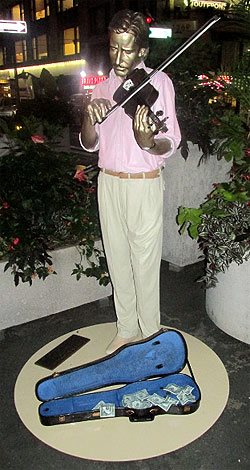
Photo by Jim Hill
… the street musician playing for tourists …

Photo by Jim Hill
Not to mention the tourists themselves.
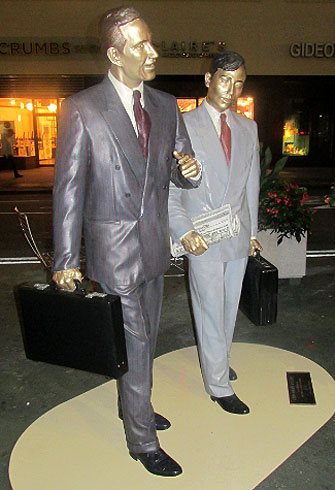
Photo by Jim Hill
But right alongside the bronze businessmen …

Photo by Jim Hill
… and the tired grandmother hauling her groceries home …
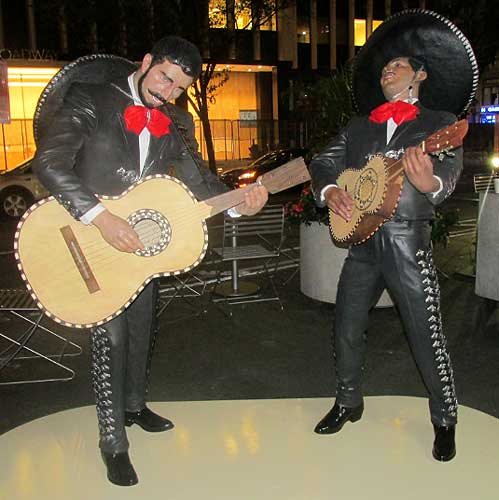
Photo by Jim Hill
… there were also statues representing people who were
from out-of-town …

Photo by Jim Hill
… or — for that matter — out-of-time.

Photo by Jim Hill
These were the Seward Johnson pieces that genuinely beguiled. Famous impressionist paintings brought to life in three dimensions.

Note the out-of-period water bottle that some tourist left
behind. Photo by Jim Hill
Some of them so lifelike that you actually had to pause for
a moment (especially as day gave way to night in the city) and say to yourself
"Is that one of the bronzes? Or just someone pretending to be one of these
bronzes?"
Mind you, for those of you who aren't big fans of the
impressionists …

Photo by Jim Hill
… there's also an array of American icons. Among them
Marilyn Monroe …
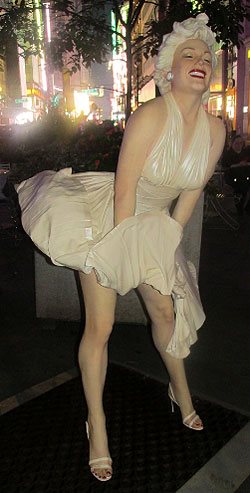
Photo by Jim Hill
… and that farmer couple from Grant Wood's "American
Gothic."

Photo by Jim Hill
But for those of you who know your NYC history, it's hard to
beat that piece which recreates Alfred Eisenstaedt's famous photograph of V-J Day in Times Square.

Photo by Jim Hill
By the way, a 25-foot-tall version of this particular Seward
Johnson piece ( which — FYI — is entitled "Embracing Peace") will actually
be placed in Times Square for a few days on or around August 14th to commemorate the 70th
anniversary of Victory Over Japan Day (V-J Day).

Photo by Jim Hill
By the way, if you'd like to check these Seward Johnson bronzes in
person (which — it should be noted — are part of the part of the Garment
District Alliance's new public art offering) — you'd best schedule a trip to
the City sometime over the next three months. For these pieces will only be on
display now through September 15th.
General
Wondering what you should “Boldly Go” see at the movies next year? The 2015 Licensing Expo offers you some clues

Greeting from the 2015 Licensing Expo, which is being held
at the Mandalay Bay
Convention Center in Las
Vegas.

Photo by Jim Hill
I have to admit that I enjoy covering the Licensing Expo.
Mostly becomes it allows bloggers & entertainment writers like myself to
get a peek over the horizon. Scope out some of the major motion pictures &
TV shows that today's vertically integrated entertainment conglomerates
(Remember when these companies used to be called movie studios?) will be
sending our way over the next two years or so.
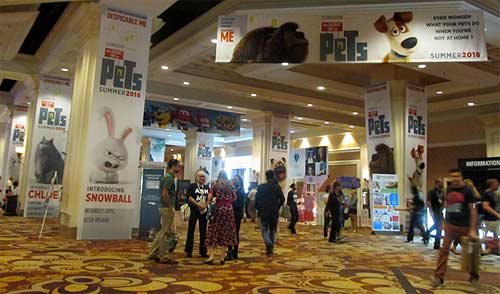
Photo by Jim Hill
Take — for example — all of "The Secret Life of
Pets" banners that greeted Expo attendees as they made their way to the
show floor today. I actually got to see some footage from this new Illumination
Entertainment production (which will hit theaters on July 8, 2016) the last time I was in Vegas. Which
was for CinemaCon back in April. And the five or so minutes of film that I viewed
suggested that "The Secret Life of Pets" will be a really funny
animated feature.

Photo by Jim Hill
Mind you, Universal Pictures wanted to make sure that Expo
attendees remembered that there was another Illumination Entertainment production
coming-to-a-theater-near-them before "The Secret Life of Pets" (And
that's "Minions," the "Despicable Me" prequel. Which
premieres at the Annecy International Animated Film Festival next week but
won't be screened stateside 'til July 10th of this year). Which is why they had
three minions who were made entirely out of LEGOS loitering out in the lobby.

Photo by Jim Hill
And Warner Bros. — because they wanted "Batman v
Superman: Dawn of Justice" to start trending on Twitter today — brought
the Batmobile to Las Vegas.
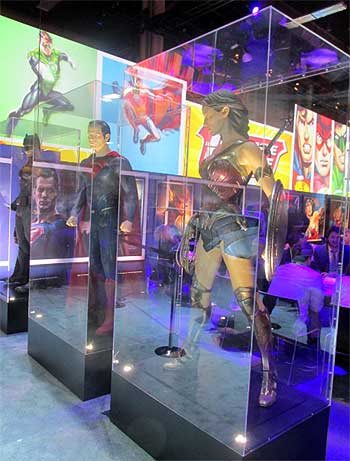
Photo by Jim Hill
Not to mention full-sized macquettes of Batman, Superman and
Wonder Woman. Just so conventioneers could then see what these DC superheroes
would actually look like in this eagerly anticipated, March 25, 2016 release.

Photo by Jim Hill
That's the thing that can sometimes be a wee bit frustrating
about the Licensing Expo. It's all about delayed gratification. You'll come
around a corner and see this 100 foot-long ad for "The Peanuts Movie"
and think "Hey, that looks great. I want to see that Blue Sky Studios production
right now." It's only then that you notice the fine print and realize that
"The Peanuts Movie" doesn't actually open in theaters 'til November
6th of this year.

Photo by Jim Hill
And fan of Blue Sky's "Ice Age" film franchise are in for an even
longer wait. Given that the latest installment in that top grossing series
doesn't arrive in theaters 'til July
15, 2016.

Photo by Jim Hill
Of course, if you're one of those people who needs immediate
gratification when it comes to your entertainment, there was stuff like that to
be found at this year's Licensing Expo. Take — for example — how the WWE
booth was actually shaped like a wrestling ring. Which — I'm guessing — meant
that if the executives of World Wrestling Entertainment, Inc. didn't like
the offer that you were making, they were then allowed to toss you out over the
top rope, Royal Rumble-style.

Photo by Jim Hill
I also have to admit that — as a longtime Star Trek fan —
it was cool to see the enormous Starship Enterprise that hung in place over the
CBS booth. Not to mention getting a glimpse of the official Star Trek 50th
Anniversary logo.
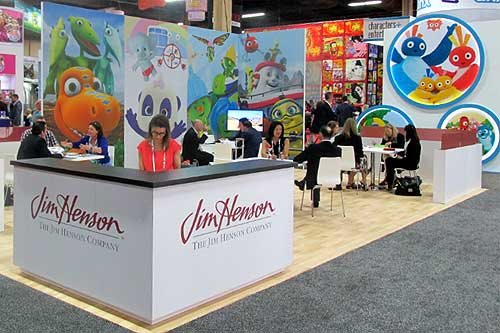
Photo by Jim Hill
I was also pleased to see lots of activity in The Jim Henson
Company booth. Which suggests that JHC has actually finally carved out a
post-Muppets identity for itself.

Photo by Jim Hill
Likewise for all of us who were getting a little concerned
about DreamWorks Animation (what with all the layoffs & write-downs &
projects that were put into turnaround or outright cancelled last year), it was
nice to see that booth bustling.

Photo by Jim Hill
Every so often, you'd come across some people who were
promoting a movie that you weren't entirely sure that you actually wanted to
see (EX: "Angry Birds," which Sony Pictures Entertainment / Columbia
Pictures will be releasing to theaters on May 20, 2016). But then you remembered that Clay Kaytis —
who's this hugely talented former Walt Disney Animation Studios animator — is
riding herd on "Angry Birds" with Fergal Reilly. And you'd think
"Well, if Clay's working on 'Angry Birds,' I'm sure this animated feature
will turn out fine."

Photo by Jim Hill
Mind you, there were reminders at this year's Licensing Expo
of great animated features that we're never going to get to see now. I still
can't believe — especially after that brilliant proof-of-concept footage
popped up online last year — that Sony execs decided not to go forward
with production of Genndy Tartakovsky's
"Popeye" movie. But that's the
cruel thing about the entertainment business, folks. It will sometime break
your heart.

Photo by Jim Hill
And make no mistake about this. The Licensing Expo is all
about business. That point was clearly driven home at this year's show when —
as you walked through the doors of the Mandalay
Bay Convention Center
— the first thing that you saw was the Hasbros Booth. Which was this gleaming,
sleek two story-tall affair full of people who were negotiating deals &
signing contracts for all of the would-be summer blockbusters that have already
announced release dates for 2019 & beyond.

Photo by Jim Hill
"But what about The Walt Disney Company?," you
ask. "Weren't they represented on the show floor at this year's Licensing
Expo?" Not really, not. I mean, sure. There were a few companies there hyping
Disney-related products. Take — for example — the Disney Wikkeez people.
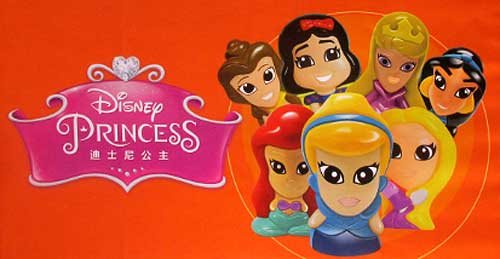
Photo by Jim Hill
I'm assuming that some Disney Consumer Products exec is
hoping that Wikkeez will eventually become the new Tsum Tsum. But to be blunt,
these little hard plastic figures don't seem to have the same huggable charm
that those stackable plush do. But I've been wrong before. So let's see what
happens with Disney Wikkeez once they start showing up on the shelves of the
Company's North American retail partners.

Photo by Jim Hill
And speaking of Disney's retail partners … They were
meeting with Mouse House executives behind closed doors one floor down from the
official show floor for this year's Licensing Expo.

Photo by Jim Hill
And the theme for this year's invitation-only Disney shindig? "Timeless
Stories" involving the Disney, Pixar, Marvel & Lucasfilm brands that
would then appeal to "tomorrow's consumer."

Photo by Jim Hill
And just to sort of hammer home the idea that Disney is no
longer the Company which cornered the market when it comes to little girls
(i.e., its Disney Princess and Disney Fairies franchises), check out this
wall-sized Star Wars-related image that DCP put up just outside of one of its
many private meeting rooms. "See?," this carefully crafted photo
screams. "It isn't just little boys who want to wield the Force. Little
girls also want to grow up and be Lords of the Sith."
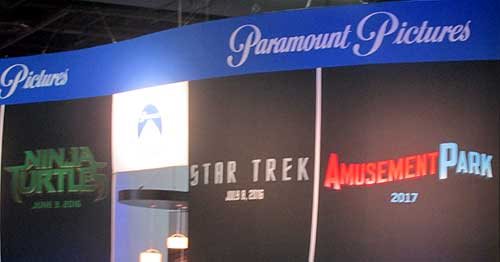
Photo by Jim Hill
One final, kind-of-ironic note: According to this banner,
Paramount Pictures will be releasing a movie called "Amusement Park"
to theaters sometime in 2017.

Photo by Jim Hill
Well, given all the "Blackfish" -related issues
that have been dogged SeaWorld Parks & Entertainment over the past two years, I'm
just hoping that they'll still be in the amusement park business come 2017.
Your thoughts?
General
It takes more than three circles to craft a Classic version of Mickey Mouse

You know what Mickey Mouse looks like, right? Little guy,
big ears?
Truth be told, Disney's corporate symbol has a lot of
different looks. If Mickey's interacting with Guests at Disneyland
Park (especially this summer, when
the Happiest Place on Earth
is celebrating its 60th anniversary), he looks & dresses like this.
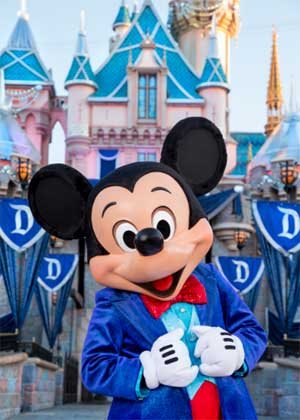
Copyright Disney Enterprises,
Inc.
All rights reserved
Or when he's appearing in one of those Emmy Award-winning shorts that Disney
Television Animation has produced (EX: "Bronco Busted," which debuts
on the Disney Channel tonight at 8 p.m. ET / PT), Mickey is drawn in a such a
way that he looks hip, cool, edgy & retro all at the same time.
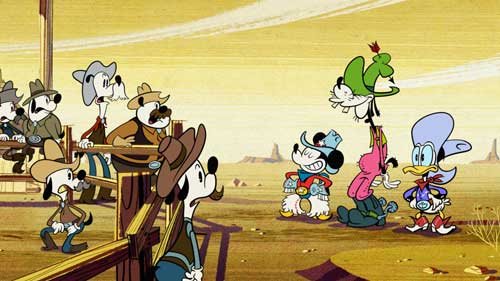
Copyright Disney Enterprises, Inc. All rights
reserved
Looking ahead to 2017 now, when Disney Junior rolls out "Mickey and the
Roadster Racers," this brand-new animated series will feature a sportier version
of Disney's corporate symbol. One that Mouse House managers hope will persuade
preschool boys to more fully embrace this now 86 year-old character.

Copyright Disney Enterprises,
Inc. All rights reserved
That's what most people don't realize about the Mouse. The
Walt Disney Company deliberately tailors Mickey's look, even his style of
movement, depending on what sort of project / production he's appearing in.
Take — for example — Disney
California Adventure
Park's "World of Color:
Celebrate!" Because Disney's main mouse would be co-hosting this new
nighttime lagoon show with ace emcee Neil Patrick Harris, Eric Goldberg really had
to step up Mickey's game. Which is why this master Disney animator created
several minutes of all-new Mouse animation which then showed that Mickey was
just as skilled a showman as Neil was.

Copyright Disney Enterprises,
Inc.
All rights reserved
Better yet, let's take a look at what the folks at Avalanche Studios just went
through as they attempted to create a Classic version of Mickey & Minnie.
One that would then allow this popular pair to become part of Disney Infinity
3.0.
"I won't lie to you. We were under a lot of pressure to
get the look of this particular version of Mickey — he's called Red Pants
Mickey around here — just right," said Jeff Bunker, the VP of Art
Development at Avalanche Studios, during a recent phone interview. "When
we brought Sorcerer Mickey into Disney Infinity 1.0 back in January of 2014,
that one was relatively easy because … Well, everyone knows what Mickey Mouse
looked like when he appeared in 'Fantasia.' "

Copyright Disney Enterprises,
Inc. All rights reserved
"But this time around, we were being asked to design
THE Mickey & Minnie," Bunker continued. "And given that these Classic
Disney characters have been around in various different forms for the better
part of the last century … Well, which look was the right look?"
Which is why Jeff and his team at Avalanche Studios began watching hours &
hours of Mickey Mouse shorts. As they tried to get a handle on which look would
work best for these characters in Disney Infinity 3.0.

Copyright Disney
Enterprises, Inc. All rights reserved
"And we went all the way back to the very start of Mickey's career. We began
with 'Steamboat Willie' and then watched all of those black & white Mickey shorts
that Walt made back in the late 1920s & early 1930s. From there, we
transitioned to his Technicolor shorts. Which is when Mickey went from being
this pie-eyed, really feisty character to more of a well-behaved leading
man," Bunker recalled. "We then finished out our Mouse marathon by
watching all of those new Mickey shorts that Paul Rudish & his team have
been creating for Disney Television Animation. Those cartoons really recapture
a lot of the spirit and wild slapstick fun that Mickey's early, black &
white shorts had."
But given that the specific assignment that Avalanche Studios had been handed
was to create the most appealing looking, likeable version of Mickey Mouse
possible … In the end, Jeff and his team wound up borrowing bits & pieces
from a lot of different versions of the world's most famous mouse. So that
Classic Mickey would then look & move in a way that best fit the sort of
gameplay which people would soon be able to experience with Disney Infinity
3.0.

Copyright Disney Enterprises,
Inc. All rights reserved
"That — in a lot of ways — was actually the toughest
part of the Classic Mickey design project. You have to remember that one of the
key creative conceits of Disney Infinity
is that all the characters which appear in this game are toys," Bunker
stated. "Okay. So they're beautifully detailed, highly stylized toy
versions of beloved Disney, Pixar, Marvel & Lucasfilm characters. But
they're still supposed to be toys. So our Classic versions of Mickey &
Minnie have the same sort of thickness & sturdiness to them that toys have.
So that they'll then be able to fit right in with all of the rest of the
characters that Avalanche Studios had previously designed for Disney Infinity."
And then there was the matter of coming up with just the
right pose for Classic Mickey & Minnie. Which — to hear Jeff tell the
story — involved input from a lot of Disney upper management.

Copyright Disney Enterprises,
Inc. All rights reserved
"Everyone within the Company seemed to have an opinion
about how Mickey & Minnie should be posed. More to the point, if you Google
Mickey, you then discover that there are literally thousands of poses out there
for these two. Though — truth be told — a lot of those kind of play off the
way Mickey poses when he's being Disney's corporate symbol," Bunker said.
"But what I was most concerned about was that Mickey's pose had to work
with Minnie's pose. Because we were bringing the Classic versions of these
characters up into Disney Infinity 3.0 at the exact same time. And we wanted to
make sure — especially for those fans who like to put their Disney Infinity
figures on display — that Mickey's pose would then complement Minnie.
Which is why Jeff & the crew at Avalanche Studios
decided — when it came to Classic Mickey & Minnie's pose — that they
should go all the way back to the beginning. Which is why these two Disney icons
are sculpted in such a way that it almost seems as though you're witnessing the
very first time Mickey set eyes on Minnie.

Copyright Disney Enterprises,
Inc. All rights reserved
"And what was really great about that was — as soon as
we began showing people within the Company this pose — everyone at Disney
quickly got on board with the idea. I mean, the Classic Mickey that we sculpted
for Disney Infinity 3.0 is clearly a very playful, spunky character. But at the
same time, he's obviously got eyes for Minnie," Bunker concluded. "So
in the end, we were able to come up with Classic versions of these characters
that will work well within the creative confines of Disney Infinity 3.0 but at
the same time please those Disney fans who just collect these figures because
they like the way the Disney Infinity characters look."
So now that this particular design project is over, does
Jeff regret that Mouse House upper management was so hands-on when it came to
making sure that the Classic versions of Mickey & Minnie were specifically
tailored to fit the look & style of gameplay found in Disney Infinity 3.0?

Copyright Lucasfilm / Disney
Enterprises, Inc. All rights reserved
"To be blunt, we go through this every time we add a new character to the
game. The folks at Lucasfilm were just as hands-on when we were designing the
versions of Darth Vader and Yoda that will also soon be appearing in Disney
Infinity 3.0," Bunker laughed. "So in the end, if the character's
creators AND the fans are happy, then I'm happy."
This article was originally posted on the Huffington Post's Entertainment page on Tuesday, June 9, 2015
-

 Theme Parks & Themed Entertainment10 months ago
Theme Parks & Themed Entertainment10 months agoDisney’s Forgotten Halloween Event: The Original Little Monsters on Main Street
-

 Theme Parks & Themed Entertainment11 months ago
Theme Parks & Themed Entertainment11 months agoThe Story of Mickey’s Not-So-Scary Halloween Party: From One Night to a Halloween Family Tradition
-

 Theme Parks & Themed Entertainment8 months ago
Theme Parks & Themed Entertainment8 months agoDisney and Macy’s 90-Year Thanksgiving Day Parade Partnership: From Mickey’s First Balloon to Minnie’s Big Debut
-

 Film & Movies10 months ago
Film & Movies10 months agoHow “An American Tail” Led to Disney’s “Hocus Pocus”
-

 Television & Shows6 months ago
Television & Shows6 months agoHow the Creators of South Park Tricked A-List Celebrities to Roast Universal – “Your Studio & You”
-

 History6 months ago
History6 months agoThe Super Bowl & Disney: The Untold Story Behind ‘I’m Going to Disneyland!’
-

 Film & Movies2 months ago
Film & Movies2 months agoBefore He Was 626: The Surprisingly Dark Origins of Disney’s Stitch
-

 Film & Movies2 months ago
Film & Movies2 months agoThe Best Disney Animation Film Never Made – “Chanticleer”








